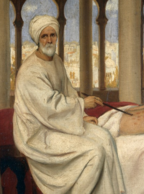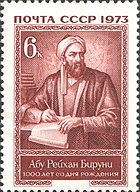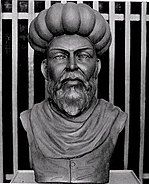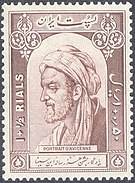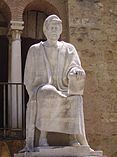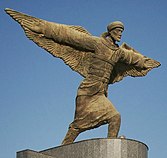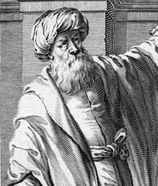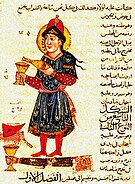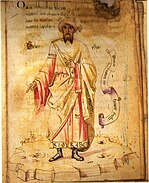Islamic Golden Age
The Islamic Golden Age was a period of scientific, economic and cultural flourishing in the history of Islam, traditionally dated from the 8th century to the 13th century.[1][2][3]
This period is traditionally understood to have begun during the reign of the Abbasid caliph Harun al-Rashid (786 to 809) with the inauguration of the House of Wisdom, which saw scholars from all over the Muslim world flock to Baghdad, the world's largest city by then, to translate the known world's classical knowledge into Arabic and Persian.[4] The period is traditionally said to have ended with the collapse of the Abbasid caliphate due to Mongol invasions and the Siege of Baghdad in 1258.[5]
There are a few alternative timelines. Some scholars extend the end date of the golden age to around 1350, including the Timurid Renaissance within it,[6][7] while others place the end of the Islamic Golden Age as late as the end of 15th to 16th centuries, including the rise of the Islamic gunpowder empires.[1][2][3]
History of the concepts
[edit]The metaphor of a golden age began to be applied in 19th-century literature about Islamic history, in the context of the western aesthetic fashion known as Orientalism. The author of a Handbook for Travelers in Syria and Palestine in 1868 observed that the most beautiful mosques of Damascus were "like Mohammedanism itself, now rapidly decaying" and relics of "the golden age of Islam".[8]
There is no unambiguous definition of the term, and depending on whether it is used with a focus on cultural or on military achievement, it may be taken to refer to rather disparate time spans. Thus, one 19th century author would have it extend to the duration of the caliphate, or to "six and a half centuries",[9] while another would have it end after only a few decades of Rashidun conquests, with the death of Umar and the First Fitna.[10]

During the early 20th century, the term was used only occasionally and often referred to as the early military successes of the Rashidun caliphs. It was only in the second half of the 20th century that the term came to be used with any frequency, now mostly referring to the cultural flourishing of science and mathematics under the caliphates during the 9th to 11th centuries (between the establishment of organised scholarship in the House of Wisdom and the beginning of the crusades),[11] but often extended to include part of the late 8th or the 12th to early 13th centuries.[12] Definitions may still vary considerably.
Equating the end of the golden age with the end of the caliphates is a convenient cut-off point based on a historical landmark, but it can be argued that Islamic culture had entered a gradual decline much earlier; thus, Khan (2003) identifies the proper golden age as being the two centuries between 750 and 950, arguing that the beginning loss of territories under Harun al-Rashid worsened after the death of al-Ma'mun in 833, and that the crusades in the 12th century resulted in a weakening of the Islamic empire from which it never recovered.[13]
Regarding the end of the Gola, Mohamad Abdalla argues the dominant approach by scholars is the "decline theory.":
The golden age is considered to have come into existence through a gigantic endeavor to acquire and translate the ancient sciences of the Greeks between the eighth and ninth centuries. The translations era was followed by two centuries of splendid original thinking and contributions, and is known as the "golden age" of Islamic science. This so-called "golden age" is supposed to have lasted from the end of the ninth to the end of the eleventh century. The era after this period is conventionally known as the "age of decline". A survey of literature from the nineteenth century onwards demonstrates that the decline theory has become the preferred paradigm in general academia.[14]
Causes
[edit]
Religious influence
[edit]The various Quranic injunctions and Hadith (or actions of Muhammad), which place values on education and emphasize the importance of acquiring knowledge, played a vital role in influencing the Muslims of this age in their search for knowledge and the development of the body of science.[15][16][17]
Government sponsorship
[edit]The Islamic Empire heavily patronized scholars. The money spent on the Translation Movement for some translations is estimated to be equivalent to about twice the annual research budget of the United Kingdom's Medical Research Council.[18] The best scholars and notable translators, such as Hunayn ibn Ishaq, had salaries that are estimated to be the equivalent of professional athletes today.[18] The House of Wisdom was a library established in Abbasid-era Baghdad, Iraq by Caliph al-Mansur[19] in 825 modeled after the academy of Jundishapur.
Openness to diverse influences
[edit]During this period, the Muslims showed a strong interest in assimilating the scientific knowledge of the civilizations that had been conquered. Many classic works of antiquity that might otherwise have been lost were translated from Greek, Syriac, Middle Persian, and Sanskrit into Syriac and Arabic, some of which were later in turn translated into other languages like Hebrew and Latin.[4]

Christians, especially the adherents of the Church of the East (Nestorians), contributed to Islamic civilization during the reign of the Umayyads and the Abbasids by translating works of Greek philosophers and ancient science to Syriac and afterwards to Arabic.[20][21] They also excelled in many fields, in particular philosophy, science (such as Hunayn ibn Ishaq,[22][23] Yusuf Al-Khuri,[24] Al Himsi,[25] Qusta ibn Luqa,[26] Masawaiyh,[27][28] Patriarch Eutychius,[29] and Jabril ibn Bukhtishu[30]) and theology. For a long period of time the personal physicians of the Abbasid Caliphs were often Assyrian Christians.[31][32] Among the most prominent Christian families to serve as physicians to the caliphs were the Bukhtishu dynasty.[33][34] Throughout the 4th to 7th centuries, Christian scholarly work in the Greek and Syriac languages was either newly translated or had been preserved since the Hellenistic period. Among the prominent centers of learning and transmission of classical wisdom were Christian colleges such as the School of Nisibis[35] and the School of Edessa,[36] the pagan center of learning in Harran,[37] and the renowned hospital and medical Academy of Gondishapur, which was the intellectual, theological and scientific center of the Church of the East.[38][39][40] Many scholars of the House of Wisdom were of Christian background and it was led by Christian physician Hunayn ibn Ishaq, with the support of Byzantine medicine. Many of the most important philosophical and scientific works of the ancient world were translated, including the work of Galen, Hippocrates, Plato, Aristotle, Ptolemy and Archimedes.[41]
Persians also were a notably high proportion of scientists who contributed to the Islamic Golden Age. According to Bernard Lewis: "Culturally, politically, and most remarkable of all even religiously, the Persian contribution to this new Islamic civilization is of immense importance. The work of Iranians can be seen in every field of cultural endeavor, including Arabic poetry, to which poets of Iranian origin composing their poems in Arabic made a very significant contribution."[42]
While cultural influence used to radiate outward from Baghdad, after the Mongol destruction of the Abbasid Caliphate, Arab influence decreased.[43] Iran and Central Asia, benefiting from increased cross-cultural access to East Asia under Mongol rule, flourished and developed more distinctively from Arab influence, such as the Timurid Renaissance under the Timurid dynasty.[44]
New technology
[edit]
With a new and easier writing system, and the introduction of paper, information was democratized to the extent that, for probably the first time in history, it became possible to make a living from only writing and selling books.[45] The use of paper spread from China into Muslim regions in the eighth century through mass production in Samarkand and Khorasan,[46] arriving in Al-Andalus on the Iberian peninsula (modern Spain and Portugal) in the 10th century. It was easier to manufacture than parchment, less likely to crack than papyrus, and could absorb ink, making it difficult to erase and ideal for keeping records. Islamic paper makers devised assembly-line methods of hand-copying manuscripts to turn out editions far larger than any available in Europe for centuries.[47] It was from these countries that the rest of the world learned to make paper from linen.[48]
Education
[edit]The centrality of scripture and its study in the Islamic tradition helped to make education a central pillar of the religion in virtually all times and places in the history of Islam.[49] The importance of learning in the Islamic tradition is reflected in a number of hadiths attributed to Muhammad, including one that states "Seeking knowledge is obligatory upon every Muslim".[49] This injunction was seen to apply particularly to scholars, but also to some extent to the wider Muslim public, as exemplified by the dictum of al-Zarnuji, "learning is prescribed for us all".[49] While it is impossible to calculate literacy rates in pre-modern Islamic societies, it is almost certain that they were relatively high, at least in comparison to their European counterparts.[49]
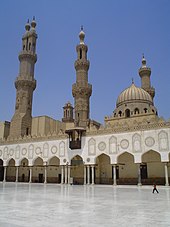
Education would begin at a young age with study of Arabic and the Quran, either at home or in a primary school, which was often attached to a mosque.[49] Some students would then proceed to training in tafsir (Quranic exegesis) and fiqh (Islamic jurisprudence), which was seen as particularly important.[49] Education focused on memorization, but also trained the more advanced students to participate as readers and writers in the tradition of commentary on the studied texts.[49] It also involved a process of socialization of aspiring scholars, who came from virtually all social backgrounds, into the ranks of the ulema.[49]
For the first few centuries of Islam, educational settings were entirely informal, but beginning in the 11th and 12th centuries, the ruling elites began to establish institutions of higher religious learning known as madrasas in an effort to secure support and cooperation of the ulema.[49] Madrasas soon multiplied throughout the Islamic world, which helped to spread Islamic learning beyond urban centers and to unite diverse Islamic communities in a shared cultural project.[49] Nonetheless, instruction remained focused on individual relationships between students and their teacher.[49] The formal attestation of educational attainment, ijaza, was granted by a particular scholar rather than the institution, and it placed its holder within a genealogy of scholars, which was the only recognized hierarchy in the educational system.[49] While formal studies in madrasas were open only to men, women of prominent urban families were commonly educated in private settings and many of them received and later issued ijazas in hadith studies, calligraphy and poetry recitation.[50][51] Working women learned religious texts and practical skills primarily from each other, though they also received some instruction together with men in mosques and private homes.[50]
Madrasas were devoted principally to study of law, but they also offered other subjects such as theology, medicine, and mathematics.[52][53] The madrasa complex usually consisted of a mosque, boarding house, and a library.[52] It was maintained by a waqf (charitable endowment), which paid salaries of professors, stipends of students, and defrayed the costs of construction and maintenance.[52] The madrasa was unlike a modern college in that it lacked a standardized curriculum or institutionalized system of certification.[52]
Muslims distinguished disciplines inherited from pre-Islamic civilizations, such as philosophy and medicine, which they called "sciences of the ancients" or "rational sciences", from Islamic religious sciences.[49] Sciences of the former type flourished for several centuries, and their transmission formed part of the educational framework in classical and medieval Islam.[49] In some cases, they were supported by institutions such as the House of Wisdom in Baghdad, but more often they were transmitted informally from teacher to student.[49]
The University of Al Karaouine, founded in 859 AD, is listed in The Guinness Book Of Records as the world's oldest degree-granting university.[54] The Al-Azhar University was another early madrasa now recognized as a university. The madrasa is one of the relics of the Fatimid caliphate. The Fatimids traced their descent to Muhammad's daughter Fatimah and named the institution using a variant of her honorific title Al-Zahra (the brilliant).[55] Organized instruction in the Al-Azhar Mosque began in 978.[56] Arabic became a trade language. The Muslim-ruled Spanish capital of Córdoba, which surpassed Constantinople[57][58] as the Europe's largest city, also became a prominent world leading centre of education and learning producing numerous polymaths.
Law
[edit]Juristic thought gradually developed in study circles, where independent scholars met to learn from a local master and discuss religious topics.[59][60] At first, these circles were fluid in their membership, but with time distinct regional legal schools crystallized around shared sets of methodological principles.[60][61] As the boundaries of the schools became clearly delineated, the authority of their doctrinal tenets came to be vested in a master jurist from earlier times, who was henceforth identified as the school's founder.[60][61] In the course of the first three centuries of Islam, all legal schools came to accept the broad outlines of classical legal theory, according to which Islamic law had to be firmly rooted in the Quran and hadith.[61][62]
The classical theory of Islamic jurisprudence elaborates how scriptures should be interpreted from the standpoint of linguistics and rhetoric.[63] It also comprises methods for establishing authenticity of hadith and for determining when the legal force of a scriptural passage is abrogated by a passage revealed at a later date.[63] In addition to the Quran and sunnah, the classical theory of Sunni fiqh recognizes two other sources of law: juristic consensus (ijmaʿ) and analogical reasoning (qiyas).[64] It therefore studies the application and limits of analogy, as well as the value and limits of consensus, along with other methodological principles, some of which are accepted by only certain legal schools.[63] This interpretive apparatus is brought together under the rubric of ijtihad, which refers to a jurist's exertion in an attempt to arrive at a ruling on a particular question.[63] The theory of Twelver Shia jurisprudence parallels that of Sunni schools with some differences, such as recognition of reason (ʿaql) as a source of law in place of qiyas and extension of the notion of sunnah to include traditions of the imams.[65]
The body of substantive Islamic law was created by independent jurists (muftis). Their legal opinions (fatwas) were taken into account by ruler-appointed judges who presided over qāḍī's courts, and by maẓālim courts, which were controlled by the ruler's council and administered criminal law.[61][63]
Theology
[edit]Classical Islamic theology emerged from an early doctrinal controversy which pitted the ahl al-hadith movement, led by Ahmad ibn Hanbal, who considered the Quran and authentic hadith to be the only acceptable authority in matters of faith, against Mu'tazilites and other theological currents, who developed theological doctrines using rationalistic methods.[66] In 833 the caliph al-Ma'mun tried to impose Mu'tazilite theology on all religious scholars and instituted an inquisition (mihna), but the attempts to impose a caliphal writ in matters of religious orthodoxy ultimately failed.[66] This controversy persisted until al-Ash'ari (874–936) found a middle ground between Mu'tazilite rationalism and Hanbalite literalism, using the rationalistic methods championed by Mu'tazilites to defend most substantive tenets maintained by ahl al-hadith.[67] A rival compromise between rationalism and literalism emerged from the work of al-Maturidi (d. c. 944), and, although a minority of scholars remained faithful to the early ahl al-hadith creed, Ash'ari and Maturidi theology came to dominate Sunni Islam from the 10th century on.[67][68]
Philosophy
[edit]
Ibn Sina (Avicenna) and Ibn Rushd (Averroes) played a major role in interpreting the works of Aristotle, whose ideas came to dominate the non-religious thought of the Christian and Muslim worlds. According to the Stanford Encyclopedia of Philosophy, translation of philosophical texts from Arabic to Latin in Western Europe "led to the transformation of almost all philosophical disciplines in the medieval Latin world".[69] The influence of Islamic philosophers in Europe was particularly strong in natural philosophy, psychology and metaphysics, though it also influenced the study of logic and ethics.[69]
Metaphysics
[edit]Ibn Sina argued his "Floating man" thought experiment concerning self-awareness, in which a man deprived of sense experience by being blindfolded and free falling would still be aware of his existence.[70]
Epistemology
[edit]In epistemology, Ibn Tufail wrote the novel Hayy ibn Yaqdhan and in response Ibn al-Nafis wrote the novel Theologus Autodidactus. Both were concerning autodidacticism as illuminated through the life of a feral child spontaneously generated in a cave on a desert island.
Mathematics
[edit]Algebra
[edit]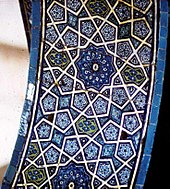
Persian mathematician Muḥammad ibn Mūsā al-Khwārizmī played a significant role in the development of algebra, arithmetic and Hindu–Arabic numerals. He has been described as the father[71][72] or founder[73][74] of algebra.
Another Persian mathematician, Omar Khayyam, is credited with identifying the foundations of Analytic geometry. Omar Khayyam found the general geometric solution of the cubic equation. His book Treatise on Demonstrations of Problems of Algebra (1070), which was a significant step in the development of algebra, is part of the body of Persian mathematics that was eventually transmitted to Europe.[75]
Yet another Persian mathematician, Sharaf al-Dīn al-Tūsī, found algebraic and numerical solutions to various cases of cubic equations.[76] He also developed the concept of a function.[77]
Calculus
[edit]Ibn al-Haytham (Alhazen) discovered the sum formula for the fourth power, using a method that could be generally used to determine the sum for any integral power. He used this to find the volume of a paraboloid. He could find the integral formula for any polynomial without having developed a general formula.[78]
Geometry
[edit]Islamic art makes use of geometric patterns and symmetries in many of its art forms, notably in girih tilings. These are formed using a set of five tile shapes, namely a regular decagon, an elongated hexagon, a bow tie, a rhombus, and a regular pentagon. All the sides of these tiles have the same length; and all their angles are multiples of 36° (π/5 radians), offering fivefold and tenfold symmetries. The tiles are decorated with strapwork lines (girih), generally more visible than the tile boundaries. In 2007, the physicists Peter Lu and Paul Steinhardt argued that girih from the 15th century resembled quasicrystalline Penrose tilings.[79][80][81][82] Elaborate geometric zellige tilework is a distinctive element in Moroccan architecture.[83] Muqarnas vaults are three-dimensional but were designed in two dimensions with drawings of geometrical cells.[84]
Jamshīd al-Kāshī's estimate of pi would not be surpassed for 180 years.[85]
Trigonometry
[edit]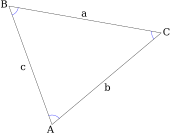
Ibn Muʿādh al-Jayyānī is one of the several Islamic mathematicians on whom the law of sines is attributed; he wrote "The Book of Unknown Arcs of a Sphere" in the 11th century. This formula relates the lengths of the sides of any triangle, rather than only right triangles, to the sines of its angles.[86] According to the law,
where a, b, and c are the lengths of the sides of a triangle, and A, B, and C are the opposite angles (see figure).
Statistics
[edit]The earliest use of statistical inference was given by Al-Kindi (c. 801–873, also known as "Alkindus" in Europe), in Risalah fi Istikhraj al-Mu'amma (A Manuscript on Deciphering Cryptographic Messages) which contains the first description of the method of frequency analysis.[87][88]
Natural sciences
[edit]Scientific method
[edit]Ibn al-Haytham (Alhazen) was a significant figure in the history of scientific method, particularly in his approach to experimentation,[89][90][91][92] and has been described as the "world's first true scientist".[93]
Avicenna made rules for testing the effectiveness of drugs, including that the effect produced by the experimental drug should be seen constantly or after many repetitions, to be counted.[94][better source needed] The physician Rhazes was an early proponent of experimental medicine and recommended using control for clinical research. He said: "If you want to study the effect of bloodletting on a condition, divide the patients into two groups, perform bloodletting only on one group, watch both, and compare the results."[95]
Astronomy
[edit]Astronomy in Islam was able to grow greatly because of several key factors. One factor was geographical: the Islamic world was close to the ancient lands of the Greeks, which held valuable ancient knowledge of the heavens in Greek manuscripts.[96] During the new Abbasid Dynasty after the movement of the capital in 762 AD to Baghdad, translators were sponsored to translate Greek texts into Arabic.[96] This translation period led to many major scientific works from Galen, Ptolemy, Aristotle, Euclid, Archimedes, and Apollonius being translated into Arabic.[96] From these translations previously lost knowledge of the cosmos was now being used to advance current astrological thinkers. The second key factor of astronomy's growth was the religious observances followed by Muslims which expected them to pray at exact times during the day.[96] These observances in timekeeping led to many questions in previous Greek mathematical astronomy, especially their timekeeping.[96]

The astrolabe was a Greek invention which was an important piece of Arabic astronomy. An astrolabe is a handheld two-dimensional model of the sky which can solve problems of spherical astronomy.[96] It is made up of lines of altitude and azimuth with an index, horizon, hour circle, zenith, Rete, star pointer, and equator to accurately show where the stars are at that given moment.[96] Use of the astrolabe is best expressed in Al-Farghani's treatise on the astrolabe due to the mathematical way he applied the instrument to astrology, astronomy, and timekeeping.[96] The earliest known Astrolabe in existence today comes from the Islamic period. It was made by Nastulus in 927-28 AD and is now a treasure of the Kuwait National Museum.[96]
In about 964 AD, the Persian astronomer Abd al-Rahman al-Sufi, writing in his Book of Fixed Stars, described a "nebulous spot" in the Andromeda constellation, the first definitive reference to what is now known to be the Andromeda Galaxy, the nearest spiral galaxy to the Milky Way.
The geocentric system developed by Ptolemy placed the sun, moon, and other planets in orbit around the Earth.[96] Ptolemy thought that the planets moved on circles called epicycles and that their centers rode on deferents. The deferents were eccentric, and the angular motion of a planet was uniform around the equant which was a point opposite the deferent center.[96] Simply, Ptolemy's models were a mathematical system for predicting the positions of the planets. One of the first to criticize this model was Ibn al-Haytham, a leader of physics in the 11th century in Cairo. Then in the 13th century Nasir al-Din al-Tusi constructed the Maragha Observatory in what is today Iran.[96] Al-Tusi found the equant dissatisfying and replaced it by adding a geometrical technique called a Tusi-couple, which generates linear motion from the sum of two circular motions. Then, Ibn al-Shatir who was working in Damascus in 1350 AD employed the Tusi-couple to successfully eliminate the equant as well as other objectionable circles that Ptolemy had used.[97] This new model properly aligned the celestial spheres and was mathematically sound.[96] This development by Ibn al-Shatir, as well as the Maragha astronomers remained relatively unknown in medieval Europe.[96]
The names for some of the stars used, including Betelgeuse, Rigel, Vega, Aldebaran, and Fomalhaut are several of the names that come directly from Arabic origins or are the translations of Ptolemy's Greek descriptions which are still in use today.[96]

Physics
[edit]Alhazen played a role in the development of optics. One of the prevailing theories of vision in his time and place was the emission theory supported by Euclid and Ptolemy, where sight worked by the eye emitting rays of light, and the other was the Aristotelean theory that sight worked when the essence of objects flows into the eyes. Alhazen correctly argued that vision occurred when light, traveling in straight lines, reflects off an object into the eyes. Al-Biruni wrote of his insights into light, stating that its velocity must be immense when compared to the speed of sound.[98]
Chemistry
[edit]The early Islamic period saw the establishment of some of the longest lived theoretical frameworks in alchemy and chemistry. The sulfur-mercury theory of metals, first attested in pseudo-Apollonius of Tyana's Sirr al-khalīqa ("The Secret of Creation", c. 750–850) and in the Arabic writings attributed to Jābir ibn Ḥayyān (written c. 850–950),[99] would remain the basis of all theories of metallic composition until the eighteenth century.[100] Likewise, the Emerald Tablet, a compact and cryptic text that all later alchemists up to and including Isaac Newton (1642–1727) would regard as the foundation of their art, first occurs in the Sirr al-khalīqa and in one of the works attributed to Jābir.[101]
Substantial advances were also made in practical chemistry. The works attributed to Jābir, and those of the Persian alchemist and physician Abū Bakr al-Rāzī (c. 865–925), contain the earliest known systematic classifications of chemical substances.[102] However, alchemists were not only interested in identifying and classifying chemical substances, but also in artificially creating them.[103] Significant examples from the medieval Islamic world include the synthesis of ammonium chloride from organic substances as described in the works attributed to Jābir,[104] and Abū Bakr al-Rāzī's experiments with vitriol, which would eventually lead to the discovery of mineral acids like sulfuric acid and nitric acid by thirteenth century Latin alchemists such as pseudo-Geber.[102]
Geodesy
[edit]Al-Biruni (973–1050) estimated the radius of the earth as 6339.6 km (modern value is c. 6,371 km), the best estimate at that time.[105]
Biology
[edit]Modern commentators have likened medieval accounts of the "struggle for existence" in the animal kingdom to the framework of the theory of evolution. Thus, in his survey of the history of the ideas which led to the theory of natural selection, Conway Zirkle noted that al-Jahiz was one of those who discussed a "struggle for existence", in his Kitāb al-Hayawān (Book of Animals), written in the 9th century.[106] In the 13th century, Nasir al-Din al-Tusi believed that humans were derived from advanced animals, saying, "Such humans [probably anthropoid apes][107] live in the Western Sudan and other distant corners of the world. They are close to animals by their habits, deeds and behavior."[107] In 1377, Ibn Khaldun in his Muqaddimah stated, "The animal kingdom was developed, its species multiplied, and in the gradual process of Creation, it ended in man and arising from the world of the monkeys."[108]
In genetics, Al-Zahrawi was the first physician to identify the hereditary nature of haemophilia.[109]
Medicine and surgery
[edit]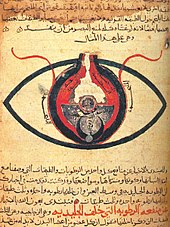
For Islamic scholars, Indian and Greek physicians and medical researchers Sushruta, Galen, Mankah, Atreya, Hippocrates, Charaka, and Agnivesha were pre-eminent authorities.[110] In order to make the Indian and Greek tradition more accessible, understandable, and teachable, Islamic scholars ordered and made more systematic the vast Indian and Greco-Roman medical knowledge by writing encyclopedias and summaries. Sometimes, past scholars were criticized, like Rhazes who criticized and refuted Galen's revered theories, most notably, the Theory of Humors and was thus accused of ignorance.[95] It was through 12th-century Arabic translations that medieval Europe rediscovered Hellenic medicine, including the works of Galen and Hippocrates, and discovered ancient Indian medicine, including the works of Sushruta and Charaka.[111][112] Works such as Avicenna's The Canon of Medicine were translated into Latin and disseminated throughout Europe. During the 15th and 16th centuries alone, The Canon of Medicine was published more than thirty-five times. It was used as a standard medical textbook through the 18th century in Europe.[113] The largely dominant theory of the time was Humorism where four separate “humors” (liquid substances, including blood, phlegm, yellow bile and dark bile) whose balance were thought to be the key to health and a natural body-temperature. In the book Al Shakook ala Jalinoos or "The Doubt on Galen" al-Razi criticized some of Galen’s theories, particularly humorism, saying that they did not agree with his own clinical observations.[114] Arab physician Ibn Zuhr provided proof that scabies is caused by the itch mite and that it can be cured by removing the parasite without the need for purging, bleeding or other treatments called for by humorism, making a break with the humorism of Galen and Avicenna.[115]
Regarding the cardiovascular system, Ibn al-Nafis in his Commentary on Anatomy in Avicenna's Canon was the first known scholar to contradict the contention of the Galen School that blood could pass between the ventricles in the heart through the cardiac inter-ventricular septum that separates them, saying that there is no passage between the ventricles at this point.[116] Instead, he correctly argued that all the blood that reached the left ventricle did so after passing through the lung.[116] He also stated that there must be small communications, or pores, between the pulmonary artery and pulmonary vein, a prediction that preceded the discovery of the pulmonary capillaries of Marcello Malpighi by 400 years. The Commentary was rediscovered in the twentieth century in the Prussian State Library in Berlin; whether its view of the pulmonary circulation influenced scientists such as Michael Servetus is unclear.[116]
In neurology, Rhazes stated that nerves had motor or sensory functions, describing 7 cranial and 31 spinal cord nerves. He assigned a numerical order to the cranial nerves from the optic to the hypoglossal nerves. He classified the spinal nerves into 8 cervical, 12 thoracic, 5 lumbar, 3 sacral, and 3 coccygeal nerves. He used this to link clinical signs of injury to the corresponding location of lesions in the nervous system.[117]
In infectious diseases, Rhazes differentiated through careful observation the two diseases smallpox and measles, which were previously lumped together as a single disease that caused rashes.[118] This was based on location and the time of the appearance of the symptoms and he also scaled the degree of severity and prognosis of infections according to the color and location of rashes.[119] Rhazes, who was once asked to choose the site for a new hospital in Baghdad, suspended pieces of meat at various points around the city, and recommended building the hospital at the location where the meat putrefied the slowest.[95]
In obstetrics and gynaecology, Al-Zahrawi was the first physician to describe an ectopic pregnancy.[109]
In pediatrics, Al-Razi is sometimes called the "Father of pediatrics" for writing the monograph, The Diseases of Children treating paediatrics as an independent field of medicine.[120]
In surgery, the tenth century Arab physician Al-Zahrawi is sometimes referred to as the "Father of surgery".[121] He describes what is thought to be the first attempt at reduction mammaplasty for the management of gynaecomastia[121] and the first mastectomy to treat breast cancer.[115] He is credited with the performance of the first thyroidectomy.[122] He wrote three textbooks on surgery, including Manual of Medial Practitioners which contains a catalog of 278 instruments used in surgery [123] In the thirteenth century, Ibn al-Quff was a physician and surgeon who published numerous books, commentaries, treatises on surgery. Most notably, he wrote Basics in the Art of Surgery, a general medical manual covering anatomy, drugs therapy and surgical care, which was by far the largest Arabic text on surgery during the entire medieval period.[124]
Engineering
[edit]The Banū Mūsā brothers, in their 9th century Book of Ingenious Devices, describe an automatic flute player which may have been the first programmable machine.[125] The flute sounds were produced through hot steam and the user could adjust the device to various patterns so that they could get various sounds from it.[126] The brothers contributed to the House of Wisdom, a research body which was established by the Abbasid Caliphate.
The 12th century scholar-inventor Ismail al-Jazari, in his writings describes of numerous mechanical devices, ideas on automation and construction methods, most notable among them being the Elephant clock.[127] While late in the 16th century, the Ottoman-era Taqi ad-Din Muhammad wrote on a mechanism that worked with the application of steam energy. He describes a self-rotating spit which was rotated by the direction of steam into the mechanism's vanes which then turns the wheel at the end of an axle,[128] this technology being an important part of the development of the steam turbine.[129]
During this time period, Roman Aqueducts were being used and expanded upon. Starting in the 9th and 10th century Arab and Moorish peasants started restoring the ruined aqueducts. The peasants also improved upon the aqueducts by localizing the technology to the respective landscapes of their area.[130] The aqueducts which were initially publicly available, built for that use by the Romans, soon became privatized. The local powers used the aqueducts to gain power in their respective communities. This later evolved to the regional royalty assuming ownership over the aqueducts in the 11th-12th centuries. Some aqueducts were utilized by the royalty to supply water to their palace wells and gardens.[130][131]
Social sciences
[edit]Ibn Khaldun is regarded to be among the founding fathers of modern sociology, historiography, demography,[n 1] and economics.[132][n 2]
Archiving was a respected position during this time in Islam though most of the governing documents have been lost over time. However, from correspondence and remaining documentation gives a hint of the social climate as well as shows that the archives were detailed and vast during their time. All letters that were received or sent on behalf of the governing bodies were copied, archived and noted for filing. The position of the archivist was seen as one that had to have a high level of devotion as they held the records of all pertinent transactions.[133]
Hospitals
[edit]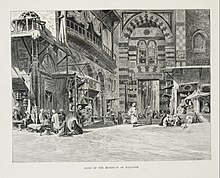
The earliest known Islamic hospital was built in 805 in Baghdad by order of Harun Al-Rashid, and the most important of Baghdad's hospitals was established in 982 by the Buyid ruler 'Adud al-Dawla.[134] The best documented early Islamic hospitals are the great Syro-Egyptian establishments of the 12th and 13th centuries.[134] By the tenth century, Baghdad had five more hospitals, while Damascus had six hospitals by the 15th century and Córdoba alone had 50 major hospitals, many exclusively for the military.[135]
The typical hospital was divided into departments such as systemic diseases, surgery, and orthopedics, with larger hospitals having more diverse specialties. "Systemic diseases" was the rough equivalent of today's internal medicine and was further divided into sections such as fever, infections and digestive issues. Every department had an officer-in-charge, a presiding officer and a supervising specialist. The hospitals also had lecture theaters and libraries. Hospitals staff included sanitary inspectors, who regulated cleanliness, and accountants and other administrative staff.[135] The hospitals were typically run by a three-man board comprising a non-medical administrator, the chief pharmacist, called the shaykh saydalani, who was equal in rank to the chief physician, who served as mutwalli (dean).[94] Medical facilities traditionally closed each night, but by the 10th century laws were passed to keep hospitals open 24 hours a day.[136]
For less serious cases, physicians staffed outpatient clinics. Cities also had first aid centers staffed by physicians for emergencies that were often located in busy public places, such as big gatherings for Friday prayers. The region also had mobile units staffed by doctors and pharmacists who were supposed to meet the need of remote communities. Baghdad was also known to have a separate hospital for convicts since the early 10th century after the vizier 'Ali ibn Isa ibn Jarah ibn Thabit wrote to Baghdad's chief medical officer that "prisons must have their own doctors who should examine them every day". The first hospital built in Egypt, in Cairo's Southwestern quarter, was the first documented facility to care for mental illnesses. In Aleppo's Arghun Hospital, care for mental illness included abundant light, fresh air, running water and music.[135][better source needed]
Medical students would accompany physicians and participate in patient care. Hospitals in this era were the first to require medical diplomas to license doctors.[137] The licensing test was administered by the region's government appointed chief medical officer. The test had two steps; the first was to write a treatise, on the subject the candidate wished to obtain a certificate, of original research or commentary of existing texts, which they were encouraged to scrutinize for errors. The second step was to answer questions in an interview with the chief medical officer. Physicians worked fixed hours and medical staff salaries were fixed by law. For regulating the quality of care and arbitrating cases, it is related that if a patient dies, their family presents the doctor's prescriptions to the chief physician who would judge if the death was natural or if it was by negligence, in which case the family would be entitled to compensation from the doctor. The hospitals had male and female quarters while some hospitals only saw men and other hospitals, staffed by women physicians, only saw women.[135] While women physicians practiced medicine, many largely focused on obstetrics.[115][better source needed]
Hospitals were forbidden by law to turn away patients who were unable to pay.[136] Eventually, charitable foundations called waqfs were formed to support hospitals, as well as schools.[136] Part of the state budget also went towards maintaining hospitals.[135] While the services of the hospital were free for all citizens[136] and patients were sometimes given a small stipend to support recovery upon discharge, individual physicians occasionally charged fees.[135] In a notable endowment, a 13th-century governor of Egypt Al-Mansur Qalawun ordained a foundation for the Qalawun hospital that would contain a mosque and a chapel, separate wards for different diseases, a library for doctors and a pharmacy[138] and the hospital is used today for ophthalmology.[135] The Qalawun hospital was based in a former Fatimid palace which had accommodation for 8,000 people – [139] "it served 4,000 patients daily."[citation needed] The waqf stated,
... The hospital shall keep all patients, men and women, until they are completely recovered. All costs are to be borne by the hospital whether the people come from afar or near, whether they are residents or foreigners, strong or weak, low or high, rich or poor, employed or unemployed, blind or sighted, physically or mentally ill, learned or illiterate. There are no conditions of consideration and payment, none is objected to or even indirectly hinted at for non-payment.[138]
Pharmacies
[edit]Arabic scholars used their natural and cultural resources to contribute to the strong development of pharmacology. They believed that God had provided the means for a cure for every disease. However, there was confusion about the nature of some ancient plants that existed during this time.[140]
A prominent figure that was influential in the development of pharmacy used the name Yuhanna Ibn Masawaiyh (c. 777-857). He was referred to as "The Divine Mesue" and "The Prince of Medicine" by European scholars. Masawaiyh led the first private medical school in Baghdad and wrote three major pharmaceutical treatises.[141] These treatises consisted of works over compound medicines, humors, and pharmaceutical recipes that provided instructions on how they were to be prepared. In the Latin West, these works were typically published together under the title "Opera Medicinalia" and were broken up into "De simplicubus", "Grabadin", and "Canones universales". Although Masawaiyh's influence was so significant that his writings became the most dominant source of pharmaceutical writings,[141] his exact identity remains unclear.[141]
In the past, all substances that were to be introduced into, on or near the human body were labeled as medicine, ranging from drugs, food, beverages, even perfumes to cosmetics.[citation needed] The earliest distinction between medicine and pharmacy as disciplines began in the seventh century, when pharmacists and apothecaries appeared in the first hospitals. Demand for drugs increased as the population increased. By the ninth century where pharmacy was established as an independent and well-defined profession by Muslim scholars. It is said by many historians that the opening of the first private pharmacy in the eighth century marks the independence of pharmacy from medicine.[140]
The emergence of medicine and pharmacy within the Islamic caliphate by the ninth century occurred at the same time as rapid expansion of many scientific institutions, libraries, schools, hospitals and then pharmacies in many Muslim cities.[citation needed] The rise of alchemy during the ninth century also played a vital role for early pharmacological development. While Arab pharmacists were not successful in converting non-precious metals into precious metals, their works giving details of techniques and lab equipment were major contributors to the development of pharmacy. Chemical techniques such as distillation, condensation, evaporation and pulverization were often used.[citation needed]
The Qur'an provided the basis for the development of professional ethics where the rise of ritual washing also influenced the importance of hygiene in pharmacology. Pharmacies were periodically visited by government inspectors called muhtasib, who checked to see that the medicines were mixed properly, not diluted and kept in clean jars. Work done by the muhtasib was carefully outlined in manuals that explained ways of examining and recognizing falsified drugs, foods and spices. It was forbidden for pharmacists to perform medical treatment without the presence of a physician, while physicians were limited to the preparation and handling of medications. It was feared that recipes would fall into the hands of someone without the proper pharmaceutical training. Licenses were required to run private practices. Violators were fined or beaten.[citation needed]
Commerce and travel
[edit]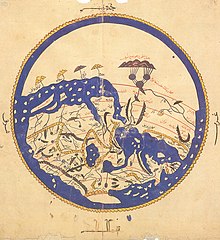
Apart from the Nile, Tigris, and Euphrates, navigable rivers were uncommon in the Middle East, so transport by sea was very important. Navigational sciences were highly developed, making use of a rudimentary sextant (known as a kamal). When combined with detailed maps of the period, sailors were able to sail across oceans rather than skirt along the coast. Muslim sailors were also responsible for reintroducing large, three-masted merchant vessels to the Mediterranean.[citation needed] The name caravel may derive from an earlier Arab boat known as the qarib.[142]
Many Muslims went to China to trade, and these Muslims began to have a great economic influence on the country. Muslims virtually dominated the import/export industry by the time of the Song dynasty (960–1279).[143] Muhammad al-Idrisi created the Tabula Rogeriana, the best maps of the Middle Ages, used by various explorers such as Christopher Columbus and Vasco Da Gama for their voyages in America and India.[144]
Agriculture
[edit]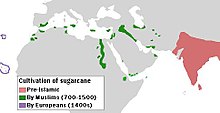
The Arabs of Al-Andalus exerted a large impact on Spanish agriculture, including the restoration of Roman-era aqueducts and irrigation channels, as well as the introduction of new technologies such as the acequias and Islamic gardens (such as at the Generalife). In Spain and Sicily, the Arabs introduced crops and foodstuffs from Persia, Khorasan, Tabaristan, Iraq, Levant, Egypt, Sindh and India such as rice, sugarcane, oranges, lemons, bananas, saffron, carrots, apricots and eggplants, as well as restoring cultivation of olives and pomegranates from Greco-Roman times. The Palmeral of Elche in southern Spain is a UNESCO World Heritage site that is emblematic of the Islamic agricultural legacy in Europe.
Arts and culture
[edit]Literature and poetry
[edit]The 13th century poet[145] Rumi (also known as Mawlana) (Romanized: mwlana) (Arabic word meaning "the great of our crowd")) wrote some of the finest poetry in the Persian language and remains one of the best selling poets in the United States.[146][147] Other famous poets of the Persian language include Hafez (whose work was read by William Jones, Thoreau, Goethe, Ralph Waldo Emerson and Friedrich Engels), Saadi (whose poetry was cited extensively by Goethe, Hegel and Voltaire), Ferdowsi, Omar Khayyam and Amir Khusrow.
One Thousand and One Nights, an anthology of Middle Eastern folk tales compiled in the Arabic language during the time of the Abbasid Caliphate, has had a large influence on Western and Middle Eastern literature and popular culture with such classics as Aladdin, Ali Baba and the Forty Thieves and Sinbad the Sailor. The folk-tale 'Sinbad the Sailor' even draws inspiration directly from Hellenistic literature like the Homeric epics (translated from Greek to Arabic in the 8th century CE) and Alexander Romances (tales of Alexander the Great popular in Europe, the Middle East and India).
Art
[edit]
Calligraphy, an essential aspect of written Arabic, developed in manuscripts and architectural decoration. This form of visual art can be found adorning the walls of palaces, the interior and domes of mosques as well as the surrounding structure of minbars.[148] Calligraphy would use a variety of stylised and standardised scripts, two major scripts among them being kufic and naskh. Ceramics, metalwork and glassware were also brilliantly decorated with geometric patterns and vibrant colors.[149]
Manuscript illumination was an important art, and Persian miniature painting flourished in the Persianate world, and went on to influence miniature art in the Ottoman and Mughal court between the 16th–17th centuries.[150][151] Very few surviving records of wall painting exists, especially ones that represented the human face. A rare example of this are the early 9th-century fragments from the ruins of the Dar al-Khilafah palace at Samarra from the Abbasid period. These are fragments of larger wall paintings depicting harem women, period-era clothing and animals.[152]
Music
[edit]The ninth and tenth centuries saw a flowering of Arabic music. Philosopher and esthete Al-Farabi,[153] at the end of the ninth century, established the foundations of modern Arabic music theory, based on the maqammat, or musical modes. His work was based on the music of Ziryab, the court musician of Andalusia. Ziryab was a renowned polymath, whose contributions to western civilization included formal dining, haircuts, chess, and more, in addition to his dominance of the world musical scene of the ninth century.[154]
The Sumerians and Akkadians, the Greeks, and the Persians all used math to create notes used on lutes and lyres and other stringed instruments. Using the idea that a plucked or bowed string produces a note, they noticed the difference in tone when a string is stopped. "The great discovery" was hearing the double octave, that halving a string produces a note one octave above the string.[155] Written as a ratio 2:1.[155]
They measured the ratios of string lengths on one side and the other of where the string was pressed, creating ratios. Those ratios allowed them to compare sounds, for example third intervals, fourths, fifths. They were able to tune one string against another in those intervals on lutes, lyres, harps, zithers. Lutes gave them the further ability to create those intervals on a single string, by adding frets at mathematically spaced distances, based on the ratios. Unlike modern instruments, where frets may be permanently fixed into the neck, as on a guitar, the older instruments used gut strings tied around the neck for frets, and this made their instruments adjustable. Early musicians could tune their instruments to different modes. Lute players could tune the strings to different intervals, and could further adjust the frets for the modes.
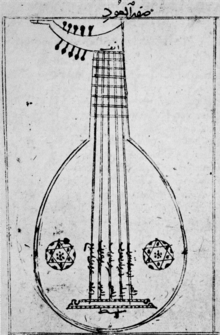
The mixing cultures of Central Asia and Arabia produced several thinkers who wrote about music, including something about the lute in their works, including Al-Kindi (c. 801 – c. 873), Ziryab (789–857), Al-Farabi (c. 872 – c. 950), Avicenna (c. 980 – 1037), and Safi al-Din al-Urmawi (1216–1294). They wrote in Arabic, what had become the useful lingua-Franca of their time, and took part in Muslim society and culture. However they were brought up in Central Asia.
The Arabs had a musical scale, described by al-Farabi, in use by some through the 13th century A.D.[156] That tanbar scale, which divided the string into "40 equal parts" may have been a leftover from Babylon and Assyria.[156] However, the Arabs traded with and conquered the Persians, and they adopted Persian scales for their lutes, just as they adopted Persian short-necked lutes.[156]
Ziryab moved from Baghdad to al-Andalus, where he set up a school of music and was one of the first to add a fifth string or course to oud, "between 822 and 852).[157] Al-Andalus, where he settled would become a center of musical instrument development for Europe.
Al-Kindi was a polymath who wrote as many as 15 music-related treatises. He was among the first to apply Greek musical theory to Central Asian-Arabian short lutes.[157] He added semi-tones between the nut and the first string.[157] He also added a fifth string to his oud in the east, as Ziryab had done in the west.[157]
Al-Farabi "fully incorporated the works of Aristoxenus and Ptolemy into his theory of tetrachords", and wrote among books in many subjects, the Kitab al-Musiqa al-Kabir, the Major Book of Music, in which he detailed how to tune an oud, using mathematical ratios.[158] He gave instruction for both 10 frets and 12, telling where to place the tied (and moveable) gut-string frets on the neck.[158] His way of tuning allowed a "12-fret 'ud tuning — which results ... 'double-octave' scale", with 22 notes in each octave.[158]
Architecture
[edit]The Great Mosque of Kairouan (in Tunisia), the ancestor of all the mosques in the western Islamic world excluding Turkey and the Balkans,[159] is one of the best preserved and most significant examples of early great mosques. Founded in 670, it dates in its present form largely from the 9th century.[160] The Great Mosque of Kairouan is constituted of a three-tiered square minaret, a large courtyard surrounded by colonnaded porticos, and a huge hypostyle prayer hall covered on its axis by two cupolas.[159]
The Great Mosque of Samarra in Iraq was completed in 847. It combined the hypostyle architecture of rows of columns supporting a flat base, above which a huge spiralling minaret was constructed.
The beginning of construction of the Great Mosque at Cordoba in 785 marked the beginning of Islamic architecture in Spain and Northern Africa. The mosque is noted for its striking interior arches. Moorish architecture reached its peak with the construction of the Alhambra, the magnificent palace/fortress of Granada, with its open and breezy interior spaces adorned in red, blue, and gold. The walls are decorated with stylized foliage motifs, Arabic inscriptions, and arabesque design work, with walls covered in geometrically patterned glazed tiles.
Many traces of Fatimid architecture exist in Cairo today, the most defining examples include the Al Azhar University and the Al Hakim mosque.
Decline
[edit]Cultural factors
[edit]Economic historian Joel Mokyr has argued that Islamic philosopher al-Ghazali (1058–1111), the author of The Incoherence of the Philosophers, "was a key figure in the decline in Islamic science" and that this led to a cultural shift shunning away from scientific thinking.[161] However, it is argued that al-Ghazali was instead an admirer and adherent of philosophy but was criticizing the use of philosophy in religious matters only.[162] Additionally, Saliba (2007) has pointed out that the golden age did not slow down after al-Ghazali, who lived in the 11th century,[163][164] while others extend the golden age to around the 16th[3] to 17th centuries.[165][166][167]
Political and economic factors
[edit]Ahmad Y. al-Hassan has rejected the thesis that lack of creative thinking was a cause, arguing that science was always kept separate from religious argument; he instead analyzes the decline in terms of economic and political factors, drawing on the work of the 14th-century writer Ibn Khaldun.[3]
Several other contemporary scholars have analysed the decline in terms of political and economic factors.[1][2] Current research has led to the conclusion that "the available evidence is consistent with the hypothesis that an increase in the political power of these elites caused the observed decline in scientific output."[168] The decline could be part of a larger trend where the non-Western world fell behind the West in the Great Divergence. In 1206, Genghis Khan established the Mongol Empire which, during the 13th century, conquered most of the Eurasian land mass, including China in the east and much of the old Islamic caliphate (as well as Kievan Rus') in the west. The destruction of Baghdad and the House of Wisdom by Hulagu Khan in 1258 has been seen by some as the end of the Islamic Golden Age.[169] However, while cultural influence used to radiate outward from Baghdad, after the fall of Baghdad, Iran and Central Asia saw a cultural flourishing by benefiting from increased cross-cultural access to East Asia under Mongol rule.[43][44]
See also
[edit]- Baghdad School
- Christian influences on the Islamic world
- Danish Golden Age
- Dutch Golden Age
- Elizabethan era
- Emirate of Sicily
- Golden age of Jewish culture in Spain
- Ibn Sina Academy of Medieval Medicine and Sciences
- Astronomy in the medieval Islamic world
- Islamic studies
- Islamic world contributions to Medieval Europe
- List of pre-modern Iranian scientists and scholars
- Ophthalmology in the medieval Islamic world
- Science in the medieval Islamic world
- Spanish Golden Age
- Timeline of science and engineering in the Muslim world
References
[edit]Notes
[edit]- ^
- "...regarded by some Westerners as the true father of historiography and sociology".[170]
- "Ibn Khaldun has been claimed the forerunner of a great number of European thinkers, mostly sociologists, historians, and philosophers".(Boulakia 1971)
- "The founding father of Eastern Sociology".[171]
- "This grand scheme to find a new science of society makes him the forerunner of many of the eighteenth and nineteenth centuries system-builders such as Vico, Comte and Marx." "As one of the early founders of the social sciences...".[172]
- ^
- "He is considered by some as a father of modern economics, or at least a major forerunner. The Western world recognizes Khaldun as the father of sociology but hesitates in recognizing him as a great economist who laid its very foundations. He was the first to systematically analyze the functioning of an economy, the importance of technology, specialization and foreign trade in economic surplus and the role of government and its stabilization policies to increase output and employment. Moreover, he dealt with the problem of optimum taxation, minimum government services, incentives, institutional framework, law and order, expectations, production, and the theory of value".Cosma, Sorinel (2009). "Ibn Khaldun's Economic Thinking". Ovidius University Annals of Economics (Ovidius University Press) XIV:52–57
Citations
[edit]- ^ a b c Saliba, George (1994). A History of Arabic Astronomy: Planetary Theories During the Golden Age of Islam. New York University Press. pp. 245, 250, 256–257. ISBN 0-8147-8023-7.
- ^ a b c King, David A. (1983). "The Astronomy of the Mamluks". Isis. 74 (4): 531–55. doi:10.1086/353360. S2CID 144315162.
- ^ a b c d Hassan, Ahmad Y (1996). "Factors Behind the Decline of Islamic Science After the Sixteenth Century". In Sharifah Shifa Al-Attas (ed.). Islam and the Challenge of Modernity, Proceedings of the Inaugural Symposium on Islam and the Challenge of Modernity: Historical and Contemporary Contexts, Kuala Lumpur, 1–5 August 1994. International Institute of Islamic Thought and Civilization (ISTAC). pp. 351–99. Archived from the original on 2 April 2015.
- ^ a b Gutas, Dimitri (1998). Greek Thought, Arabic Culture: The Graeco-Arabic Translation Movement in Baghdad and Early 'Abbāsid Society (2nd-4th/8th-10th Centuries). London: Routledge.[page needed]
- ^ Islamic Radicalism and Multicultural Politics. Taylor & Francis. 1 March 2011. p. 9. ISBN 978-1-136-95960-8. Retrieved 26 August 2012.
- ^ "Science and technology in Medieval Islam" (PDF). History of Science Museum. Retrieved 31 October 2019.
- ^ Ruggiero, Guido (15 April 2008). A Companion to the Worlds of the Renaissance, Guido Ruggiero. John Wiley & Sons. ISBN 978-0-470-75161-9. Archived from the original on 8 November 2016. Retrieved 7 November 2016.
- ^ Josias Leslie Porter, A Handbook for Travelers in Syria and Palestine, 1868, p. 49.
- ^ New Outlook, vol. 45, 1892, p. 370,
For six centuries and a half, through the golden age of Islam, lasted this Caliphate, till extinguished by the Osmanli sultans and in the death of the last of the blood of the house of Mahomet. The true Caliphate ended with the fall of Bagdad.
- ^ The Literary World, vol. 36, 1887, p. 308,
the golden age of Islam, as Mr. Gilman points out, ended with Omar, the second of the Kalifs.
[title missing] - ^ "The Ninth, Tenth and Eleventh centuries were the golden age of Islam" Life magazine, 9 May 1955, [1].
- ^ S. George, Linda (1998). The Golden Age of Islam. Benchmark Books. ISBN 978-0-7614-0273-2.
- ^ Khan, Arshad (2003). Islam, Muslims, and America: Understanding the Basis of Their Conflict. Algora Publishing. p. 19. ISBN 978-0-87586-243-9.
- ^ Mohamad Abdalla, "Ibn Khaldun on the Fate of Islamic Science after the 11th Century", Islam & Science 5.1 (2007). online
- ^ Groth, Hans, ed. (2012). Population Dynamics in Muslim Countries: Assembling the Jigsaw. Springer Science+Business Media. p. 45. ISBN 978-3-642-27881-5.
- ^ Rafiabadi, Hamid Naseem, ed. (2007). Challenges to Religions and Islam: A Study of Muslim Movements, Personalities, Issues and Trends, Part 1. Sarup & Sons. p. 1141. ISBN 978-81-7625-732-9.
- ^ Salam, Abdus (1994). Renaissance of Sciences in Islamic Countries. World Scientific. p. 9. ISBN 978-9971-5-0946-0.
- ^ a b "In Our Time – Al-Kindi, James Montgomery". BBC. 28 June 2012. Archived from the original on 14 January 2014. Retrieved 18 May 2013.
- ^ Brentjes, Sonja; Robert G. Morrison (2010). "The Sciences in Islamic societies". The New Cambridge History of Islam. Vol. 4. Cambridge: Cambridge University Press. p. 569.
- ^ Hill, Donald (1993). Islamic Science and Engineering. Edinburgh University Press. p. 4. ISBN 0-7486-0455-3.
- ^ "Nestorian – Christian sect". Archived from the original on 28 October 2016. Retrieved 5 November 2016.
- ^ Rashed, Roshdi (2015). Classical Mathematics from Al-Khwarizmi to Descartes. Routledge. p. 33. ISBN 978-0-415-83388-2.
- ^ "Hunayn ibn Ishaq – Arab scholar". Archived from the original on 31 May 2016. Retrieved 12 July 2016.
- ^ O'Leary, De Lacy (2016). How greek science passed on to the arabs. Routledge. ISBN 978-1-138-97205-6. OCLC 1039098187.[page needed]
- ^ Sarton, George. "History of Islamic Science". Archived from the original on 12 August 2016.
- ^ Siraisi, Nancy G. (2001). Medicine and the Italian Universities, 1250–1600. Brill Academic Publishers. p. 134.
- ^ Beeston, Alfred Felix Landon (1983). Arabic literature to the end of the Umayyad period. Cambridge University Press. p. 501. ISBN 978-0-521-24015-4. Retrieved 20 January 2011.
- ^ "Compendium of Medical Texts by Mesue, with Additional Writings by Various Authors". World Digital Library. Archived from the original on 4 March 2014. Retrieved 1 March 2014.
- ^ Griffith, Sidney H. (15 December 1998). "Eutychius of Alexandria". Encyclopædia Iranica. Archived from the original on 2 January 2017. Retrieved 7 February 2011.
- ^ Contadini, Anna (2003). "A Bestiary Tale: Text and Image of the Unicorn in the Kitāb naʿt al-hayawān (British Library, or. 2784)" (PDF). Muqarnas. 20: 17–33. doi:10.1163/22118993-90000037. JSTOR 1523325.
- ^ Bonner, Bonner; Ener, Mine; Singer, Amy (2003). Poverty and charity in Middle Eastern contexts. SUNY Press. p. 97. ISBN 978-0-7914-5737-5.
- ^ Ruano, Eloy Benito; Burgos, Manuel Espadas (1992). 17e Congrès international des sciences historiques: Madrid, du 26 août au 2 septembre 1990. Comité international des sciences historiques. p. 527. ISBN 978-84-600-8154-8.
- ^ Rémi Brague, Assyrians contributions to the Islamic civilization Archived 27 September 2013 at the Wayback Machine
- ^ Britannica, Nestorian Archived 30 March 2014 at the Wayback Machine
- ^ Foster, John (1939). The Church of the T'ang Dynasty. Great Britain: Society for Promoting Christian Knowledge. p. 31.
The school was twice closed, in 431 and 489
- ^ The School of Edessa Archived 2 September 2016 at the Wayback Machine, Nestorian.org.
- ^ Frew, Donald (2012). "Harran: Last Refuge of Classical Paganism". The Pomegranate: The International Journal of Pagan Studies. 13 (9): 17–29. doi:10.1558/pome.v13i9.17.
- ^ University of Tehran Overview/Historical Events Archived 3 February 2011 at the Wayback Machine
- ^ Kaser, Karl The Balkans and the Near East: Introduction to a Shared History Archived 18 November 2022 at the Wayback Machine p. 135.
- ^ Yazberdiyev, Almaz Libraries of Ancient Merv Archived 4 March 2016 at the Wayback Machine Yazberdiyev is Director of the Library of the Academy of Sciences of Turkmenistan, Ashgabat.
- ^ Hyman and Walsh Philosophy in the Middle Ages Indianapolis, 1973, p. 204' Meri, Josef W. and Jere L. Bacharach, Editors, Medieval Islamic Civilization Vol. 1, A–K, Index, 2006, p. 304.
- ^ Lewis, Bernard (2004). From Babel to Dragomans: Interpreting the Middle East. Oxford University Press. p. 44. ISBN 978-0-19-517336-9.
- ^ a b Bulliet, Richard (2005). The Earth and Its Peoples. Boston: Houghton Mifflin. p. 497. ISBN 0-618-42770-8.
- ^ a b Subtelny, Maria Eva (November 1988). "Socioeconomic Bases of Cultural Patronage under the Later Timurids". International Journal of Middle East Studies. 20 (4): 479–505. doi:10.1017/S0020743800053861. S2CID 162411014. Retrieved 7 November 2016.
- ^ "In Our Time – Al-Kindi, Hugh Kennedy". BBC. 28 June 2012. Archived from the original on 14 January 2014. Retrieved 18 May 2013.
- ^ Bloom, Jonathan (2001). Paper Before Print: The History and Impact of Paper in the Islamic World. New Haven: Yale University Press. pp. 8–10, 42–45. ISBN 0-300-08955-4.
- ^ "Islam's Gift of Paper to the West". Web.utk.edu. 29 December 2001. Archived from the original on 27 May 2015. Retrieved 11 April 2014.
- ^ Kevin M. Dunn, Caveman chemistry: 28 projects, from the creation of fire to the production of plastics. Universal-Publishers. 2003. p. 166. ISBN 978-1-58112-566-5. Retrieved 11 April 2014.
- ^ a b c d e f g h i j k l m n o Jonathan Berkey (2004). "Education". In Richard C. Martin (ed.). Encyclopedia of Islam and the Muslim World. MacMillan Reference USA.
- ^ a b Lapidus, Ira M. (2014). A History of Islamic Societies. Cambridge University Press (Kindle edition). p. 210. ISBN 978-0-521-51430-9.
- ^ Berkey, Jonathan Porter (2003). The Formation of Islam: Religion and Society in the Near East, 600–1800. Cambridge University Press. p. 227.
- ^ a b c d Lapidus, Ira M. (2014). A History of Islamic Societies. Cambridge University Press (Kindle edition). p. 217. ISBN 978-0-521-51430-9.
- ^ Hallaq, Wael B. (2009). An Introduction to Islamic Law. Cambridge University Press. p. 50.
- ^ The Guinness Book Of Records, Published 1998, ISBN 0-553-57895-2, p. 242
- ^ Halm, Heinz. The Fatimids and their Traditions of Learning. London: The Institute of Ismaili Studies and I.B. Tauris. 1997.
- ^ Donald Malcolm Reid (2009). "Al-Azhar". In John L. Esposito (ed.). The Oxford Encyclopedia of the Islamic World. Oxford: Oxford University Press. doi:10.1093/acref/9780195305135.001.0001. ISBN 978-0-19-530513-5.
- ^ Idris El Hareir; Ravane Mbaye (2011). The Spread of Islam Throughout the World. UNESCO. p. 448. ISBN 978-92-3-104153-2. Archived from the original on 14 January 2024. Retrieved 7 April 2020.
- ^ J. Bradford De Long and Andrei Shleifer (October 1993), "Princes and Merchants: European City Growth before the Industrial Revolution" (PDF), The Journal of Law and Economics, 36 (2): 671–702 [678], CiteSeerX 10.1.1.164.4092, doi:10.1086/467294, S2CID 13961320, archived from the original (PDF) on 29 July 2018, retrieved 7 December 2019
- ^ Lapidus, Ira M. (2014). A History of Islamic Societies. Cambridge University Press (Kindle edition). p. 125. ISBN 978-0-521-51430-9.
- ^ a b c Hallaq, Wael B. (2009). An Introduction to Islamic Law. Cambridge University Press. pp. 31–35.
- ^ a b c d Vikør, Knut S. (2014). "Sharīʿah". In Emad El-Din Shahin (ed.). The Oxford Encyclopedia of Islam and Politics. Oxford University Press. Archived from the original on 2 February 2017. Retrieved 30 July 2017.
- ^ Lapidus, Ira M. (2014). A History of Islamic Societies. Cambridge University Press (Kindle edition). p. 130. ISBN 978-0-521-51430-9.
- ^ a b c d e Calder, Norman (2009). "Law. Legal Thought and Jurisprudence". In John L. Esposito (ed.). The Oxford Encyclopedia of the Islamic World. Oxford: Oxford University Press. Archived from the original on 31 July 2017. Retrieved 30 July 2017.
- ^ Ziadeh, Farhat J. (2009). "Uṣūl al-fiqh". In John L. Esposito (ed.). The Oxford Encyclopedia of the Islamic World. Oxford: Oxford University Press. doi:10.1093/acref/9780195305135.001.0001. ISBN 978-0-19-530513-5.
- ^ Kamali, Mohammad Hashim (1999). John Esposito (ed.). Law and Society. Vol. The Oxford History of Islam (Kindle ed.). Oxford University Press. pp. 121–122.
- ^ a b Lapidus, Ira M. (2014). A History of Islamic Societies. Cambridge University Press (Kindle edition). pp. 130–31. ISBN 978-0-521-51430-9.
- ^ a b Blankinship, Khalid (2008). Tim Winter (ed.). The early creed. Vol. The Cambridge Companion to Classical Islamic Theology. Cambridge University Press (Kindle edition). p. 53.
- ^ Tamara Sonn (2009). "Tawḥīd". In John L. Esposito (ed.). The Oxford Encyclopedia of the Islamic World. Oxford: Oxford University Press. doi:10.1093/acref/9780195305135.001.0001. ISBN 978-0-19-530513-5.
- ^ a b Dag Nikolaus Hasse (2014). "Influence of Arabic and Islamic Philosophy on the Latin West". Stanford Encyclopedia of Philosophy. Archived from the original on 20 October 2017. Retrieved 31 July 2017.
- ^ "In Our Time: Existence". bbcnews.com. 8 November 2007. Archived from the original on 17 October 2013. Retrieved 27 March 2013.
- ^ Boyer, Carl B., 1985. A History of Mathematics, p. 252. Princeton University Press.
- ^ Gandz, S. (1936). "The Sources of Al-Khowārizmī's Algebra". Osiris. 1: 263–277. doi:10.1086/368426. JSTOR 301610. S2CID 60770737.
- ^ ""The first true algebra text which is still extant is the work on al-jabr and al-muqabala by Mohammad ibn Musa al-Khwarizmi, written in Baghdad around 825"" (PDF). Archived from the original (PDF) on 27 March 2019.
- ^ Esposito, John L. (6 April 2000). The Oxford History of Islam. Oxford University Press. p. 188. ISBN 978-0-19-988041-6.
- ^ Mathematical Masterpieces: Further Chronicles by the Explorers, p. 92
- ^ O'Connor, John J.; Robertson, Edmund F., "Sharaf al-Din al-Muzaffar al-Tusi", MacTutor History of Mathematics Archive, University of St Andrews
- ^ Katz, Victor J.; Barton, Bill (18 September 2007). "Stages in the History of Algebra with Implications for Teaching". Educational Studies in Mathematics. 66 (2): 185–201. doi:10.1007/s10649-006-9023-7. S2CID 120363574.
- ^ Katz, Victor J. (1995). "Ideas of Calculus in Islam and India". Mathematics Magazine. 68 (3): 163–74 [165–69, 173–74]. doi:10.2307/2691411. JSTOR 2691411.
- ^ Peter J. Lu; Paul J. Steinhardt (2007). "Decagonal and Quasi-crystalline Tilings in Medieval Islamic Architecture". Science. 315 (5815): 1106–10. Bibcode:2007Sci...315.1106L. doi:10.1126/science.1135491. PMID 17322056. S2CID 10374218.
- ^ "Advanced geometry of Islamic art". BBC News. 23 February 2007.
- ^ Ball, Philip (22 February 2007). "Islamic tiles reveal sophisticated maths". Nature: news070219–9. doi:10.1038/news070219-9. S2CID 178905751.
- ^ Greene, Richard Allen (5 October 2011). "Nobel goes to scientist who knocked down 'Berlin Wall' of chemistry". CNN.
- ^ Castera, Jean Marc; Peuriot, Francoise (1999). Arabesques. Decorative Art in Morocco. Art Creation Realisation. ISBN 978-2-86770-124-5.
- ^ van den Hoeven, Saskia; van der Veen, Maartje (2010). "Muqarnas-Mathematics in Islamic Arts" (PDF). Archived from the original (PDF) on 6 May 2019. Retrieved 21 May 2019.
- ^ "Ghiyath al-Din Jamshid Mas'ud al-Kashi". University of St Andrews. 1999. Retrieved 29 December 2021.
- ^ "Abu Abd Allah Muhammad ibn Muadh Al-Jayyani". University of St.Andrews. Archived from the original on 29 May 2016. Retrieved 27 July 2013.
- ^ Ibrahim A. Al-Kadi (April 1992), "The origins of cryptology: The Arab contributions", Cryptologia 16 (2): 97–126
- ^ Sahinaslan, Ender; Sahinaslan, Onder (2 April 2019). "Cryptographic methods and development stages used throughout history". AIP Conference Proceedings. 2086 (1): 030033. Bibcode:2019AIPC.2086c0033S. doi:10.1063/1.5095118. ISSN 0094-243X.
Al-Kindi is considered the first code breaker
- ^ El-Bizri, Nader (September 2005). "A philosophical perspective on Alhazen's optics". Arabic Sciences and Philosophy. 15 (2): 189–218. doi:10.1017/S0957423905000172. S2CID 123057532.
- ^ Haq, Syed Nomanul (22 December 2009). "Science in Islam". Islam & Science. 7 (2): 151–159. Gale A217042312.
- ^ Sabra, A.I. (1989). The Optics of Ibn al-Haytham. Books I–II–III: On Direct Vision. London: The Warburg Institute, University of London. pp. 25–29. ISBN 0-85481-072-2.
- ^ Toomer, G. J. (1 December 1964). "Ibn al-Haythams Weg zur Physik. Matthias Schramm". Isis. 55 (4): 463–465. doi:10.1086/349914.
- ^ Al-Khalili, Jim (4 January 2009). "The 'first true scientist'". BBC News.
- ^ a b "The Islamic roots of modern pharmacy". aramcoworld.com. Archived from the original on 18 May 2016. Retrieved 28 May 2016.
- ^ a b c Hajar, R (2013). "The Air of History (Part IV): Great Muslim Physicians Al Rhazes". Heart Views. 14 (2): 93–95. doi:10.4103/1995-705X.115499. PMC 3752886. PMID 23983918.
- ^ a b c d e f g h i j k l m n o Gingerich, Owen (1986). "Islamic Astronomy". Scientific American. 254 (4): 74–83. Bibcode:1986SciAm.254d..74G. doi:10.1038/scientificamerican0486-74. JSTOR 24975932.
- ^ Saliba, George (1982). "The Development of Astronomy in Medieval Islamic Society". Arab Studies Quarterly. 4 (3): 211–225. JSTOR 41857627.
- ^ J J O'Connor; E F Robertson (1999). "Abu Arrayhan Muhammad ibn Ahmad al-Biruni". MacTutor History of Mathematics archive. University of St Andrews. Archived from the original on 21 November 2016. Retrieved 17 July 2017.
- ^ Kraus, Paul (1942–1943). Jâbir ibn Hayyân: Contribution à l'histoire des idées scientifiques dans l'Islam. I. Le corpus des écrits jâbiriens. II. Jâbir et la science grecque. Cairo: Institut Français d'Archéologie Orientale. ISBN 978-3-487-09115-0. OCLC 468740510. vol. II, p. 1, note 1; Weisser, Ursula (1980). Das "Buch über das Geheimnis der Schöpfung" von Pseudo-Apollonios von Tyana. Berlin: De Gruyter. doi:10.1515/9783110866933. ISBN 978-3-11-007333-1. p. 199. On the dating and historical background of the Sirr al-khalīqa, see Kraus 1942−1943, vol. II, pp. 270–303; Weisser 1980, pp. 39–72. On the dating of the writings attributed to Jābir, see Kraus 1942−1943, vol. I, pp. xvii–lxv.
- ^ Norris, John A. (March 2006). "The Mineral Exhalation Theory of Metallogenesis in Pre-Modern Mineral Science". Ambix. 53 (1): 43–65. doi:10.1179/174582306X93183. S2CID 97109455.
- ^ Weisser, Ursula (1980). Das "Buch über das Geheimnis der Schöpfung" von Pseudo-Apollonios von Tyana. Berlin: De Gruyter. doi:10.1515/9783110866933. ISBN 978-3-11-007333-1. p. 46. On Newton's alchemy, see Newman, William R. (2019). Newton the Alchemist: Science, Enigma, and the Quest for Nature's Secret Fire. Princeton: Princeton University Press. ISBN 978-0-691-17487-7.
- ^ a b Karpenko, Vladimír; Norris, John A. (2002). "Vitriol in the History of Chemistry". Chemické listy. 96 (12): 997–1005.
- ^ See Newman, William R. (2004). Promethean Ambitions: Alchemy and the Quest to Perfect Nature. Chicago: University of Chicago Press. ISBN 978-0-226-57524-7.
- ^ Kraus, Paul (1942–1943). Jâbir ibn Hayyân: Contribution à l'histoire des idées scientifiques dans l'Islam. I. Le corpus des écrits jâbiriens. II. Jâbir et la science grecque. Cairo: Institut Français d'Archéologie Orientale. ISBN 978-3-487-09115-0. OCLC 468740510. Vol. II, pp. 41–42.
- ^ Pingree, David (1985). "Bīrūnī, Abū Rayḥān iv. Geography". Encyclopaedia Iranica. Columbia University. ISBN 978-1-56859-050-9.
- ^ Zirkle, Conway (25 April 1941). "Natural Selection before the "Origin of Species"". Proceedings of the American Philosophical Society. 84 (1): 71–123. JSTOR 984852.
- ^ a b Farid Alakbarov (Summer 2001). A 13th-Century Darwin? Tusi's Views on Evolution Archived 13 December 2010 at the Wayback Machine, Azerbaijan International 9 (2).
- ^ "Rediscovering Arabic Science". Saudi Aramco Magazine. Archived from the original on 30 October 2014. Retrieved 13 July 2016.
- ^ a b Cosman, Madeleine Pelner; Jones, Linda Gale (2008). Handbook to Life in the Medieval World. Handbook to Life Series. Vol. 2. Infobase Publishing. pp. 528–30. ISBN 978-0-8160-4887-8.
- ^ Cyril Elgood, A Medical History of Persia and the Eastern Caliphate, (Cambridge University Press, 1951), p. 3.
- ^ K. Mangathayaru (2013). Pharmacognosy: An Indian perspective. Pearson education. p. 54. ISBN 978-93-325-2026-4.
- ^ Lock, Stephen (2001). The Oxford Illustrated Companion to Medicine. Oxford University Press. p. 607. ISBN 978-0-19-262950-0.
- ^ A.C. Brown, Jonathan (2014). Misquoting Muhammad: The Challenge and Choices of Interpreting the Prophet's Legacy. Oneworld Publications. p. 12. ISBN 978-1-78074-420-9.
- ^ Amr, Samir; Tbakhi, Abdulghani (2007). "Abu Bakr Muhammad Ibn Zakariya Al Razi (Rhazes): Philosopher, Physician and Alchemist". Annals of Saudi Medicine. 27 (4): 305–307. doi:10.5144/0256-4947.2007.305. PMC 6074295. PMID 17684438.
- ^ a b c "Pioneer Muslim Physicians". aramcoworld.com. Archived from the original on 21 March 2017. Retrieved 20 March 2017.
- ^ a b c West, John (2008). "Ibn al-Nafis, the pulmonary circulation, and the Islamic Golden Age". Journal of Applied Physiology. 105 (6): 1877–80. doi:10.1152/japplphysiol.91171.2008. PMC 2612469. PMID 18845773.
- ^ Souayah, N; Greenstein, JI (2005). "Insights into neurologic localization by Rhazes, a medieval Islamic physician". Neurology. 65 (1): 125–28. doi:10.1212/01.wnl.0000167603.94026.ee. PMID 16009898. S2CID 36595696.
- ^ "Abu Bakr Mohammad Ibn Zakariya al-Razi (Rhazes) (c. 865-925)". sciencemuseum.org.uk. Archived from the original on 6 May 2015. Retrieved 31 May 2015.
- ^ "Rhazes Diagnostic Differentiation of Smallpox and Measles". ircmj.com. Archived from the original on 15 August 2015. Retrieved 31 May 2015.
- ^ Elgood, Cyril (2010). A Medical History of Persia and The Eastern Caliphate (1st ed.). London: Cambridge. pp. 202–203. ISBN 978-1-108-01588-2.
By writing a monograph on 'Diseases in Children' he may also be looked upon as the father of paediatrics.
- ^ a b Ahmad, Z. (May 2007). "Al-Zahrawi: The father of surgery". ANZ Journal of Surgery. 77 (s1): A83. doi:10.1111/j.1445-2197.2007.04130_8.x. S2CID 57308997.
- ^ Ignjatovic, Mile (2003). "Historical review of the thyroid gland surgery". Acta Chirurgica Iugoslavica. 50 (3): 9–36. doi:10.2298/aci0303009i. PMID 15179751.
- ^ Alexakos, Konstantinos; Antoine, Wladina (2005). "The Golden Age of Islam and Science Teaching: Teachers and students develop a deeper understanding of the foundations of modern science by learning about the contributions of Arab-Islamic scientists and scholars". The Science Teacher. 72 (3): 36–39. JSTOR 24137786.
- ^ Pormann, Peter E.; Savage-Smith, Emilie (2007). Medieval Islamic Medicine. Edinburgh University Press. p. 61. ISBN 978-0-7486-2066-1.
- ^ Koetsier, Teun (May 2001). "On the prehistory of programmable machines: musical automata, looms, calculators". Mechanism and Machine Theory. 36 (5): 589–603. doi:10.1016/S0094-114X(01)00005-2.
- ^ Banu Musa Brothers (1979), The Book of Ingenious Devices (Kitāb al-Hiyal), translated by Routledge Hill, Donald, Springer, pp. 76–77, ISBN 978-90-277-0833-5
- ^ Guy V., Beckwith (1997). Readings in Technology and Civilization. Pearson Custom Publishing. p. 290. ISBN 978-0-536-00579-3.
- ^ Hill, Donald R. (1978). "Review of Taqī-al-Dīn and Arabic Mechanical Engineering. With the Sublime Methods of Spiritual Machines. An Arabic Manuscript of the Sixteenth Century". Isis. 69 (1): 117–118. doi:10.1086/351968. JSTOR 230643.
- ^ Darke, Diana (2022). "Chapter 5". The Ottomans: A Cultural Legacy. Thames & Hudson. ISBN 978-0-500-77753-4.
- ^ a b "Arab world (general)". Encyclopedia of Women & Islamic Cultures. doi:10.1163/1872-5309_ewic_ewiccom_0304. Retrieved 2 December 2023.
- ^ Jervis, Ben; Kyle, Alison (2012). Make-do and mend: archaeologies of compromise, repair and reuse. BAR. Oxford: Archaeopress. ISBN 978-1-4073-1006-0.
- ^ * Spengler, Joseph J. (1964). "Economic Thought of Islam: Ibn Khaldun". Comparative Studies in Society and History. 6 (3): 268–306. doi:10.1017/s0010417500002164. JSTOR 177577. S2CID 143498971. .
• Boulakia, Jean David C. (1971). "Ibn Khaldûn: A Fourteenth-Century Economist". Journal of Political Economy. 79 (5): 1105–18. doi:10.1086/259818. JSTOR 1830276. S2CID 144078253.. - ^ Posner, Ernest (1972). "Archives in Medieval Islam". American Archivist. 35 (3–4): 291–315. doi:10.17723/aarc.35.3-4.x1546224w7621152.
- ^ a b Savage-Smith, Emilie; Klein-Franke, F.; Zhu, Ming (2012). "Ṭibb". In P. Bearman; Th. Bianquis; C.E. Bosworth; E. van Donzel; W.P. Heinrichs (eds.). Encyclopaedia of Islam (2nd ed.). Brill. doi:10.1163/1573-3912_islam_COM_1216.
- ^ a b c d e f g "The Islamic Roots of the Modern Hospital". aramcoworld.com. Archived from the original on 21 March 2017. Retrieved 20 March 2017.
- ^ a b c d Rise and spread of Islam. Gale. 2002. p. 419. ISBN 978-0-7876-4503-8.
- ^ Alatas, Syed Farid (2006). "From Jami'ah to University: Multiculturalism and Christian–Muslim Dialogue". Current Sociology. 54 (1): 112–32. doi:10.1177/0011392106058837. S2CID 144509355.
- ^ a b Philip Adler; Randall Pouwels (2007). World Civilizations. Cengage Learning. p. 198. ISBN 978-1-111-81056-6. Retrieved 1 June 2014.
- ^ Bedi N. Şehsuvaroǧlu (24 April 2012). "Bīmāristān". In P. Bearman; Th. Bianquis; C.E. Bosworth; et al. (eds.). Encyclopaedia of Islam (2nd ed.). Archived from the original on 20 September 2016. Retrieved 5 June 2014.
- ^ a b King, Anya (2015). "The New materia medica of the Islamicate Tradition: The Pre-Islamic Context". Journal of the American Oriental Society. 135 (3): 499–528. doi:10.7817/jameroriesoci.135.3.499. JSTOR 10.7817/jameroriesoci.135.3.499.
- ^ a b c De Vos, Paula (December 2013). "The 'Prince of Medicine': Yūḥannā ibn Māsawayh and the Foundations of the Western Pharmaceutical Tradition". Isis. 104 (4): 667–712. doi:10.1086/674940. PMID 24783490. S2CID 25175809.
- ^ "History of the caravel". Nautarch.tamu.edu. Archived from the original on 6 May 2015. Retrieved 13 April 2011.
- ^ "Islam in China". BBC. 2 October 2002. Archived from the original on 6 January 2016. Retrieved 13 July 2016.
- ^ Houben, 2002, pp. 102–104.
- ^ Lewis, Franklin D. (1 November 2007). Rumi, Past and Present, East and West: The Life, Teachings and Poetry of Jalâl al-Din Rumi (2nd ed.). Oneworld Publications. p. 9. ISBN 9781851685493.
- ^ Haviland, Charles (30 September 2007). "The roar of Rumi – 800 years on". BBC News. Archived from the original on 30 July 2012. Retrieved 10 August 2011.
- ^ "Islam: Jalaluddin Rumi". BBC. 1 September 2009. Archived from the original on 23 January 2011. Retrieved 10 August 2011.
- ^ Madden, Edward H. (1975). "Some Characteristics of Islamic Art". The Journal of Aesthetics and Art Criticism. 33 (4): 423–430. doi:10.2307/429655. JSTOR 429655.
- ^ Mason, Robert B. (1995). New Looks at Old Pots: Results of Recent Multidisciplinary Studies of Glazed Ceramics from the Islamic World. Brill Academic Publisher.
- ^ Fisher, Carol Garrett (1984). "A Reconstruction of the Pictorial Cycle of the "Siyar-i Nabī" of Murād III". Ars Orientalis. 14: 75–94. ISSN 0571-1371. JSTOR 4629330.
- ^ Verma, S.P. (2000). "Mughal Painting, Patrons and Painters". Proceedings of the Indian History Congress. 61: 510–526. ISSN 2249-1937. JSTOR 44148128.
- ^ "BBC Radio 4 - A History of the World in 100 Objects, Inside The Palace: Secrets At Court (700 - 950 AD), Harem wall painting fragments - Episode Transcript – Episode 52 - Harem wall painting fragments". BBC. Retrieved 26 April 2022.
- ^ Haque, Amber (1 December 2004). "Psychology from Islamic Perspective: Contributions of Early Muslim Scholars and Challenges to Contemporary Muslim Psychologists". Journal of Religion and Health. 43 (4): 357–377. doi:10.1007/s10943-004-4302-z. S2CID 38740431.
- ^ Epstein, Joel (2019). The Language of the Heart. Juwal Publishing. ISBN 978-1-0701-0090-6.)
- ^ a b Dumbrill, Richard J. (2005). The Archaeomusicology of the Ancient Near East. Trafford Publishing. pp. ii–iii. ISBN 978-1-4120-5538-3.
- ^ a b c Farmer, Henry George (April 1937). "The Lute Scale of Avicenna". The Journal of the Royal Asiatic Society of Great Britain and Ireland. 69 (2): 245–246. doi:10.1017/S0035869X00085397. JSTOR 25201498. S2CID 163662254.
- ^ a b c d Farmer, Henry George (April 1937). "The Lute Scale of Avicenna". The Journal of the Royal Asiatic Society of Great Britain and Ireland (2): 247–248. JSTOR 25201498.
- ^ a b c Forster, Christiano M.L. "Musical Mathematics on the art and science of acoustic instruments, Chapter 11". chrysalis-foundation.org. Retrieved 19 September 2018.
Before we continue with Al-Farabi's 12-fret 'ud tuning — which results in a 22-tone "double-octave" scale ... Al-Farabi concludes 'After these, no note of the 'ud remains which needs to be reproduced. In each octave, there are twenty-two notes; and these are all the notes used by the 'ud. Some of them are more frequently used than others.'
- ^ a b John Stothoff Badeau and John Richard Hayes, The Genius of Arab civilization: source of Renaissance. Taylor & Francis. 1 January 1983. p. 104. ISBN 978-0-262-08136-8. Retrieved 11 April 2014.
- ^ "Great Mosque of Kairouan (Qantara mediterranean heritage)". Qantara-med.org. Archived from the original on 9 February 2015. Retrieved 11 April 2014.
- ^ Mokyr, Joel (12 June 2018). Mokyr, J.: A Culture of Growth: The Origins of the Modern Economy. (eBook and Hardcover). Princeton University Press. p. 67. ISBN 978-0-691-18096-0. Archived from the original on 24 March 2017. Retrieved 9 March 2017.
{{cite book}}:|website=ignored (help) - ^ "Bringing Muslims back to science". Al Jazeera. 11 April 2014. Retrieved 11 June 2022.
- ^ "Did al-Ghazali Kill the Science in Islam?". Fountain Magazine. 1 May 2012.
- ^ "The Fountain Magazine – Issue – Did al-Ghazali Kill the Science in Islam?". www.fountainmagazine.com. Archived from the original on 30 April 2015. Retrieved 8 March 2018.
- ^ El-Rouayheb, Khaled (2008). "The Myth of "The Triumph of Fanaticism" in the Seventeenth-Century Ottoman Empire". Die Welt des Islams. 48 (2): 196–221. doi:10.1163/157006008x335930.
- ^ El-Rouayheb, Khaled (2006). "Opening the Gate of Verification: The Forgotten Arab-Islamic Florescence of the 17th Century". International Journal of Middle East Studies. 38 (2): 263–81. doi:10.1017/s0020743806412344 (inactive 1 November 2024). S2CID 162679546.
{{cite journal}}: CS1 maint: DOI inactive as of November 2024 (link) - ^ El-Rouhayeb, Khaled (2015). Islamic Intellectual History in the Seventeenth Century: Scholarly Currents in the Ottoman Empire and the Maghreb. Cambridge: Cambridge University Press. pp. 1–10. ISBN 978-1-107-04296-4.
- ^ "Religion and the Rise and Fall of Islamic Science". scholar.harvard.edu. Archived from the original on 22 December 2015. Retrieved 20 December 2015.
- ^ Cooper, William W.; Yue, Piyu (2008). Challenges of the Muslim world: present, future and past. Emerald Group Publishing. ISBN 978-0-444-53243-5. Retrieved 11 April 2014.
- ^ Gates, Warren E. (1967). "The Spread of Ibn Khaldûn's Ideas on Climate and Culture". Journal of the History of Ideas. 28 (3): 415–22. doi:10.2307/2708627. JSTOR 2708627.
- ^ Dhaouadi, M. (1 September 1990). "Ibn Khaldun: The Founding Father of Eastern Sociology". International Sociology. 5 (3): 319–35. doi:10.1177/026858090005003007. S2CID 143508326.
- ^ Haddad, L. (1 May 1977). "A Fourteenth-Century Theory of Economic Growth and Development". Kyklos. 30 (2): 195–213. doi:10.1111/j.1467-6435.1977.tb02006.x.
Further reading
[edit]- Adballa, Mohamad (Summer 2007). "Ibn Khaldun on the fate of Islamic science after the 11th century". Journal of Islam & Science. 5 (1).
- Allsen, Thomas T. (2004). Culture and conquest in Mongol Eurasia. Cambridge studies in Islamic civilization. Cambridge: Cambridge University Press. ISBN 978-0-521-60270-9.
- Hayes, John Richard; Atiyeh, George N.; Hayes, John R., eds. (1992). The Genius of Arab civilization: source of Renaissance (3rd ed.). New York: New York University Press. p. 306. ISBN 978-0-8147-3485-8.
- Epstein, Joel (2019). The Language of the Heart: A musical, fantastical journey through a land of magic. [independently published]. ISBN 978-1-07-010090-6.
- Falagas, Matthew E.; Zarkadoulia, Effie A.; Samonis, George (August 2006). "Arab science in the golden age (750–1258 C.E.) and today". The FASEB Journal. 20 (10): 1581–1586. doi:10.1096/fj.06-0803ufm. ISSN 0892-6638. PMID 16873881. S2CID 40960150.
- Fernández-Morera, Darío (2016). The myth of the Andalusian paradise: Muslims, Christians, and Jews under Islamic rule in medieval Spain. Wilmington, DE: ISI Books. ISBN 978-1-61017-095-6.
- Huff, Toby E. (2017). The rise of early modern science: Islam, China, and the West (3rd ed.). Cambridge New York Port Melbourne Delhi Singapore: Cambridge University Press. ISBN 978-1-107-13021-0.
- Kheirandish, Elaheh (2021). Baghdad and Isfahan: a dialogue of two cities in an age of science ca. 750-1750. London: I.B. Tauris. ISBN 978-0-7556-3508-5.
- Lombard, Maurice (2004). The golden age of Islam. Translated by Spencer, Joan. Preface by Jane Hathaway. Princeton, NJ: Markus Wiener Publishers. ISBN 978-1-55876-322-7.
- Makdisi, George (April 1989). "Scholasticism and Humanism in Classical Islam and the Christian West". Journal of the American Oriental Society. 109 (2): 175–182. doi:10.2307/604423. JSTOR 604423.
- Meri, Josef W. (2006). Meri, Josef W.; Bacharach, Jere L. (eds.). Medieval Islamic civilization: an encyclopedia. Routledge encyclopedias of the Middle Ages. New York: Routledge. p. 1088. ISBN 978-0-415-96691-7.
- Starr, S. Frederick (2015). Lost enlightenment: Central Asia's golden age from the Arab conquest to Tamerlane (PDF). Princeton, NJ ; Oxford: Princeton University Press. ISBN 978-0-691-16585-1.
- Sonn, Tamara (2010). Islam: a brief history (PDF). Blackwell brief histories of religion series (2nd ed.). Chichester, West Sussex: Wiley-Blackwell. pp. 39–79. ISBN 978-1-4051-8094-8.
External links
[edit] Media related to Islamic Golden Age at Wikimedia Commons
Media related to Islamic Golden Age at Wikimedia Commons- Islamicweb.com: History of the Golden Age
- Khamush.com: Baghdad: Metropolis of the Abbasid Caliphate – Chapter 5 Archived 20 September 2020 at the Wayback Machine, by Gaston Wiet.
- U.S. Library of Congress.gov: The Kirkor Minassian Collection – contains examples of Islamic book bindings.
- Islamic Golden Age
- Science in the medieval Islamic world
- Islamic culture
- Medieval Islamic world
- Medieval European education
- 8th-century Islam
- 9th-century Islam
- 10th-century Islam
- 12th-century Islam
- 13th-century Islam
- Religion in the Middle Ages
- Science in the Middle Ages
- 8th century in the Middle East
- 9th century in the Middle East
- 10th century in the Middle East
- 11th century in the Middle East
- 12th century in the Middle East
- 13th century in the Middle East
- Golden ages (metaphor)

